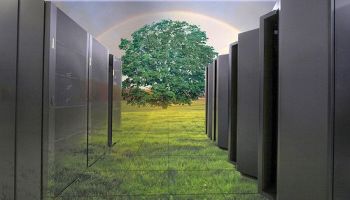HP Launches Containerised, Green ‘EcoPOD’

HP’s EcoPOD can be deployed in 12 weeks, costs 75 percent less to build, and cuts energy costs by 95 percent
Hewlett-Packard executives are launching a new modular data centre offering that can be deployed and run at a fraction of the capital and power costs of a traditional facility.
HP, which five years ago joined a growing number of systems vendors that began offering modular, containerised data centres with its POD (Performance Optimised Data Centre), unveiled its latest offering at its HP Discover 2011 event in Las Vegas.
Lower costs
The POD 240a – which HP officials also call the “EcoPOD” – is designed to enable businesses to get a new data centre more quickly, and run it at much lower costs than they would with brick-and-mortar facilities, according to Mark Potter, vice president and general manager of HP’s Industry Standard Servers and Software unit.
The comparisons are stark, Potter said during a 6 June webcast from the event. It takes about two years to build a relatively small data centre at a cost of $33m (£20m), he said. It also costs about $1.54 million a year to power the building, which usually has a PUE (Power Usage Effectiveness) rating of about 2.4. The PUE is a metric used to measure the energy efficiency of a building based on a ratio of the amount of energy that comes into a building and how much of that energy is actually used to run the systems. The closer to 1 that score is, the better.
By contrast, an EcoPod – which will be generally available in North America by the end of the year – will cost about $8.3 million, will cost about $55,200 for power every year and can be deployed in about 12 weeks. It will have a PUE of about 1.05, Potter said.
The EcoPod will be entirely self-contained, with the capacity for up to 4,400 servers in up to 44 standard 50U racks, and will offer the same capabilities in 900 square feet that traditional data centres have in 10,000 square feet. A key will be the use of HP’s Adaptive Cooling technology, developed in part by HP Labs. The technology optimises energy savings based on IT workloads, climate and policy by adjusting cooling methods, including outside air. That enables businesses to drive down energy costs by as much as 95 percent over typical data centres.
The new POD is part of HP’s larger Converged Infrastructure programme, and comes at a time when the rapid growth of data – driven in large part by web browsers and mobile computing – is increasing the demand on data centres, creating what Potter called a “capacity crisis”.
Fast delivery
Businesses are being forced to quickly adapt to this demand and the ensuing changes, and waiting two years for an expensive and power-hungry data centre won’t work anymore, he said. HP sees the EcoPOD – like its other modular data centres – as able to fill a number of roles, including as a new data centre, to add capacity to an existing facility or for disaster recovery.
Most vendors – including IBM, Dell, SGI and Cisco Systems – have similar offerings, the first of which was Sun Microsystems’ Project Blackbox, introduced in 2006. Potter argued that despite the other offerings, HP’s was the most complete, thanks to its broad portfolio of product lines.
The ability to deliver the technology quickly is key, Potter said, noting that in the fall of 2010, HP was able to deliver 40,000 servers to Microsoft in 22 PODs in nine weeks for the software giant’s expanded cloud-computing efforts.
“We’re the only ones with the experience to bring it all together,” he said.
